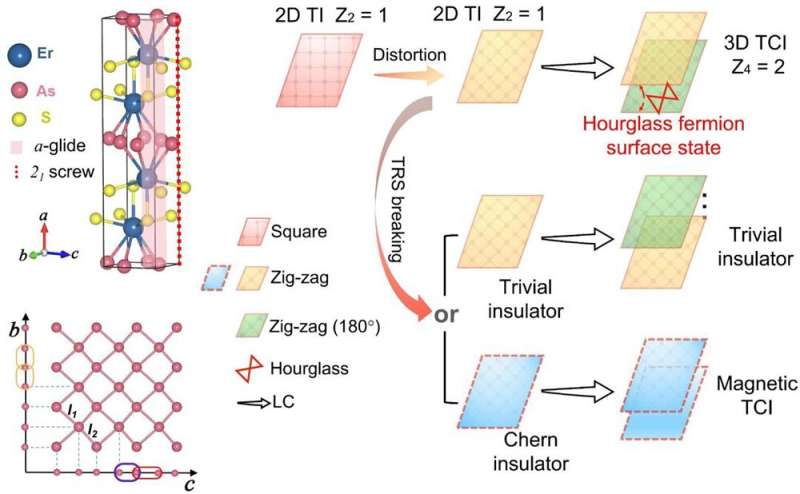Scientists design and synthesize a new layered air-stable topological crystalline insulator candidate

Exploring novel topological materials and related phase transitions has been a central research theme in condensed matter physics and materials science. Topological materials with nontrivial anti-band crossings have attracted much attention. Hourglass fermion surface state, located at the vertex in the neck of an hourglass-like dispersion, enables exploration of remarkable topological phases, such as the hourglass Weyl point, movement along high symmetry lines, and hourglass nodal chains or net. By introducing nonsymmorphic symmetry-preserved interlayer couplings, the hourglass fermion surface state in topological crystalline insulators (TCIs) can be obtained.
Since scientists theoretically predicted the nonsymmorphic TCIs KHgX (X = As, Sb, and Bi) having the hourglass-like dispersion in 2016, the experiments using different techniques have been conducted to observe the hourglass-like dispersion in KHgSb, layered compounds M3SiTe6 (M = Nb, Ta), and three-dimensional bulk systems like perovskite iridates or some oxides with nonsymmorphic symmetry. However, hourglass fermion surface states are rarely verified for the drawbacks including air-sensitivity, miscellaneous band dispersions crossing Fermi level (EF), and challenging of cleavage in the candidates mentioned above. Thus, it is highly desired to discover suitable candidate materials with hourglass fermion surface states to explore their intriguing properties and new topological phases.
In 2020, Qian et al. theoretically demonstrated that hourglass fermion surface state can be realized in orthorhombic LaSbTe with zig-zag Sb-atom layers stacking along an axis with nonsymmorphic symmetry. However, orthorhombic LaSbTe has not become experimentally available so far, rather tetragonal LaSbTe and La-substituted RESbTe (RE = rare earth) have been reported.
Recently, Chen Hongxiang, Chen Long, Prof. Wang Gang Wang, et al. from the Institute of Physics of the Chinese Academy of Sciences (IOP, CAS), together with collaborators, have designed and synthesized a new layered air-stable topological crystalline insulator candidate ErAsS.
The crystal structure of ErAsS is determined to be orthorhombic Pnma (No. 62) using single crystal X-ray diffraction and further confirmed by high-angle annular-dark-field using scanning transmission electron microscopy.
According to the results of single crystal neutron diffraction at COROLLI, SNS and first principles calculations, the distorted As-atom layer and magnetic order of Er in this newly discovered material induce not only the hourglass fermion surface state, but also the magnetic-tuned exotic phases including the possible magnetic topological crystalline insulator.
Published in Advanced Materials, these results show a new and experimentally available TCI candidate with hourglass fermion surface state and exotic phases tuned by magnetic structure, demonstrating the potential of deeply investigating the hourglass fermion surface state and the interplay between magnetism and topology.
More information: Hongxiang Chen et al, Topological Crystalline Insulator Candidate ErAsS with Hourglass Fermion and Magnetic‐Tuned Topological Phase Transition, Advanced Materials (2022). DOI: 10.1002/adma.202110664
Journal information: Advanced Materials
Provided by Chinese Academy of Sciences





















